We may earn money or products from the companies mentioned in this post.
Preschool planning shouldn’t be stressful. In fact, I think we should plan our whole week on one-page.
But, as parents, we want to make sure we’re preparing our preschoolers for kindergarten. We want to make sure we cover all the important topics. So, we end up stressing ourselves out worrying about what to include and how to plan our days.
Time and time again I hear from parents who are worried. They’re anxious that they’re leaving important things out. They want their days to have structure. They want to cover all the important things and make sure their child is ready for the future. But, they also want to keep their days fun and relaxed.
So, how do you get the most out of your preschool learning while encouraging curiosity, allowing time to investigate and making play a priority?
The simplest way to do this is to start with a few goals for your school year, assess current development, and then choose activities based on a theme.
Some simple planning will allow you to relax and enjoy your preschool days.
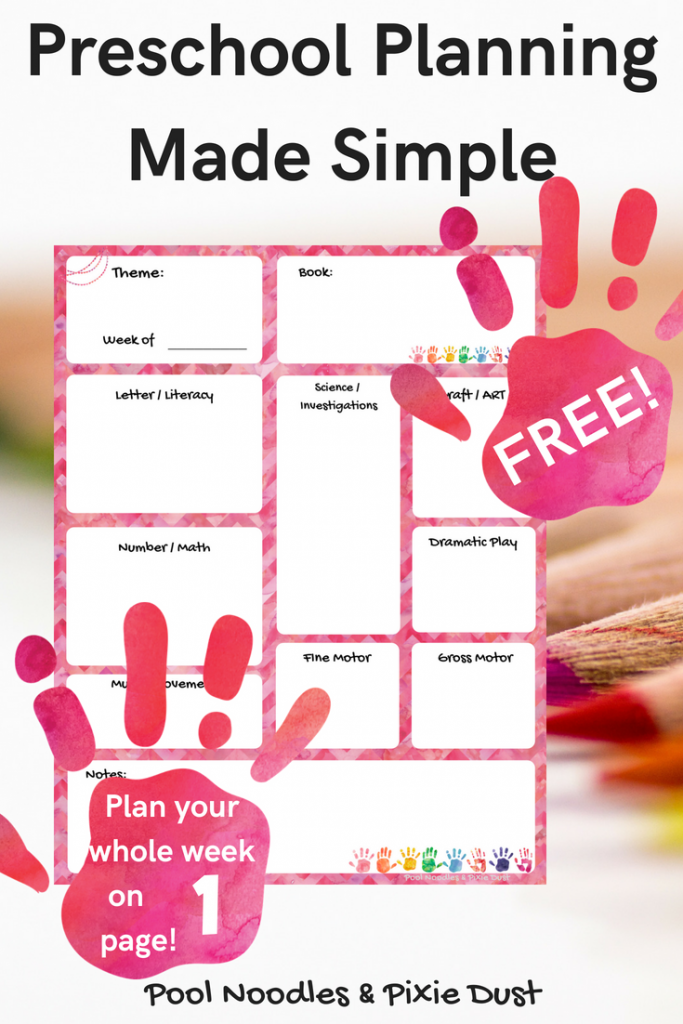
Simple Goal Setting in Preschool Planning
A simple way to know where you’re heading during the school year is to do some simple goal setting. It should be a list of things you’re working towards with your child. Creating this list will give you a place to check in on progress at different points in the year.
Your goals can be anything from learning the alphabet to spending more time outside doing nature study.
Start by writing down your big goals, then you can break those up into more specific goals to help you figure out how to start progressing.
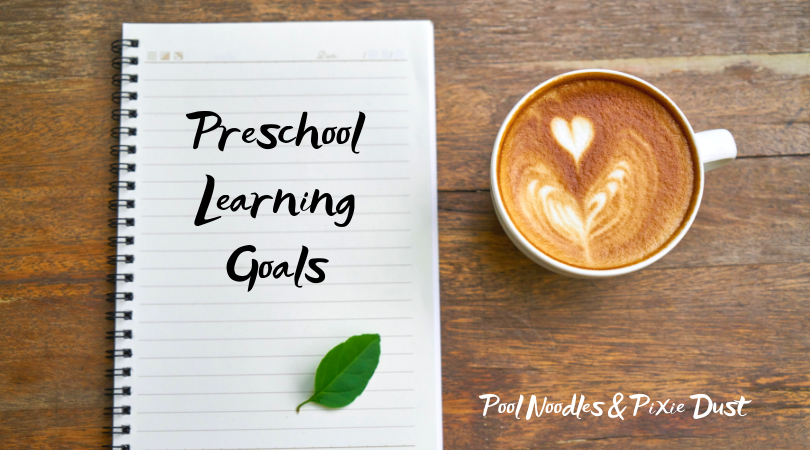
It’s a good idea to start with some basic questions about how you want your days to look and feel. Ask yourself questions about how you’d like your routine to look. And, what activities you want to put emphasis on.
Projects, nature study, artwork? What do you and your child want to spend more time doing? Playing outside more often? Learning new games?
Next, think about specific education-related goals. Do you hope to teach your child their alphabet this year? Do you want them to learn to count to ten? What about helping them deal with emotions? Or creating an independent handwashing habit?
Having goals will ensure that you’re not constantly worried about missing something and help you to enjoy preschool. It also sets a relaxed tone for your days, where you know you’re giving your child the education and learning experiences you were hoping to each day.
Skills Assessment in Preschool Planning
Before we go any further I think it’s important to remember that all children will master skills at different ages and on their own individual timeline. A child’s age, while a marker on developmental charts, should not be the only means of assessment. Each child is an individual and will reflect that in how and when they learn any skill.
That being said, a simple skills assessment does help to give you a starting place for planning activities. But, let it be just that, a starting point.
Honing in on where your child is and concerning yourself with making progress from there, instead of worrying about where they should be, will create a gentle and fun learning environment for your preschooler.
Questions to ask
What are some developmental milestones, my child should be working on?
What do they already have mastered?
Knowing where my child is currently, what would I like to work towards this school year?
If you’re not sure where to start, my Kindergarten Readiness Assessment can help you get organized and assess the basics.
I’ve also linked to two lists for you below so you can get a general idea.
Developmental Milestones: 3-4-year-olds from healthychildren.org
Developmental Milestones: 4-5-year-olds healthychildren.org
Preschool Planning Categories
To get started, make a list of the areas you want to plan for, such as literacy, math, social-emotional, fine motor, and gross motor development, including a simple end goal that you have in mind.
For example, one of your ultimate literacy goals for your preschooler this year could be that they recognize all of their upper and lowercase letters. And, you may have more than one in each category.
Once you have this list you need to go a step further and choose the specific skills you’d like to work on with your child. Instead of just listing ‘alphabet’ get much more specific looking back at your goals and your child’s skills assessment and list things like lowercase letter recognition.
Now, do this for every category you are planning to include in your schedule. It’s ok if you don’t have any specific goals for certain areas.
Here’s an example of what this might look like:
Literacy — Be able to recognize the upper and lowercase alphabet
Phonics — Learn letter sounds
Math — learn numbers 1-10 or count from 1-20
Fine Motor — Holding a pencil with proper grip
Gross Motor — Practice pumping a swing by themselves
This list can also include much more personal to your child goals like working on controlling emotions, following directions, and other skills related to independence. And, the ways that you could practice those skills in your home.
As you can see from my list above it gets very specific about your child’s individual needs. It should be about recognizing where your child is currently and working towards progress.
While writing these things down try to make sure that your list doesn’t get too long. Allow lots of time for play, exploration, discovery, and investigation. Children learn so much about the world through play. And, most of that learning happens in the times we plan the least for it.
Also, move to the next skill as your child is ready, not on some artificial timeline. As home educators, we get to make our own timeline and really allow our children to grow and progress at their own pace. Take full advantage of that opportunity.
Use Themes to Simplify Preschool Planning
The next step in simple preschool planning is to choose a theme. Using themes to plan your weeks and months will make your life so much easier.
The easiest place to start is with a great children’s book to focus your activities around. A good book is like a cheat sheet for you providing ideas for art, rhyming activities, counting activities, letter of the week or phonic focus among other ideas.
Using a theme streamlines the planning process by reigning in your mind and giving it an area to focus on. Choose a different weekly theme or choose one theme for each month.
In my experience, a monthly theme allows for life’s interruptions. Inevitably when I plan weekly themes I don’t get to everything on my schedule and then I’m feeling rushed to put out another theme. It doesn’t allow for deep investigation and rabbit holes; one of my very favorite parts of homeschooling!
It’s also practical to use one theme for the whole month because it’s less work to come up with materials to use. Preparing materials like games and centers become easier because you do it just once for the whole month. It makes for a less rushed atmosphere and that is so beneficial to you and your child.
Bonus points if you choose something your child is already interested in. Half the work is already done for you if your child is on board. When they’re excited about the topic they are much more engaged with any activity you provide.
Plan Activities
So now it’s time to put your list of skills and your chosen theme together. The goal is to choose fun activities that specifically address the skills you want to work on.
For example, using a set of alphabet cards to match upper and lowercase letters is a simple activity you can put together and use all month to reinforce that specific skill. Using games, center style activities, crafts, and hands-on work pages make learning more fun and natural.
Simplified Assessment
Using games and centers is also a great assessment tool. All you have to do is watch your child working on that letter matching, for instance, and notice them progress from novice to master at the skills involved.
At that point, you can move onto a more challenging game or activity that will assess a new skill.
Step-By-Step Example of a Preschool Week
Ok, so now we’re going to walk through a week of preschool planning. In this example, we will use an Ocean Theme.
Let’s start with a great children’s book like Swimmy by Leo Leoni. I love the artwork in this book. Using the categories on my preschool planning pages here is a breakdown of sample activities to get you started planning one week of ocean themed activities. Obviously, yours will reflect the specific skills you’re trying to work on.

Theme: Ocean
Book: Swimmy by Leo Leoni
Social/Emotional Activity: Discuss during read-aloud time how Swimmy might feel during the story. Swimmy experiences loneliness as he swims around discovering the ocean. Talk about times your child felt lonely. What can they do when they feel lonely?
Read-alouds are a fantastic way to talk about emotions and increase empathy in our children. And really deep thinking can occur easily during a simple 10-minute reading and discussion of a book.
Letter focus: O is for Ocean – Letter of the Week – Letter O
Literacy Activity and Sensory Play: Practice writing letters by tracing them in the sand.
Math Activity: Cut out some simple fish shapes from construction paper to make a school of fish. Number two fish each with numbers 11-20 to create a simple matching game.
Fine Motor: Provide a cardboard fish template for tracing and scissors to cut them out.
Gross Motor: Crabwalk around the house or outside in the backyard. Or spend the day swimming in the ocean or backyard kiddie pool.
Dramatic Play: Set up an under the sea area using a sheet or blanket where your child can imagine they are swimming around the ocean. Hang green crepe paper “seaweed” and cut-outs or drawings of ocean animals.
Music & Movement: “The Goldfish (Let’s Go Swimming)” by the Laurie Berkner Band
Science Investigations: Here’s a list of 10 Insanely Easy Ocean Science Experiments from Rochelle Barlow of ASLRochelle.
Craft: Use paper doilies and paint to make prints of an underwater ocean scene. Set the book nearby so your child can see the artwork in the book. They might be surprised to see that the illustrations include doily prints!
Preschool Planning Pages
I’ve been meaning to create a preschool planning page for a while now. My goal was to create one-page that would cover all your planning for one-week. That meant I had to get right to the heart of what to cover.
But, every child needs different things, every child learns differently. So, I made the planning sheet using categories that most people are looking to cover in preschool. But, the download also includes a blank planning page template so that you can add in your own categories or leave some off if you want. As well as a goal setting page and a page to list out materials and activities by day of the week if you would like.
Grab Your FREE PRINTABLE PLANNING PAGES HERE in my shop!
I hope these ideas give you some peace of mind about preschool planning.
Have fun planning your preschool days!
Heidi
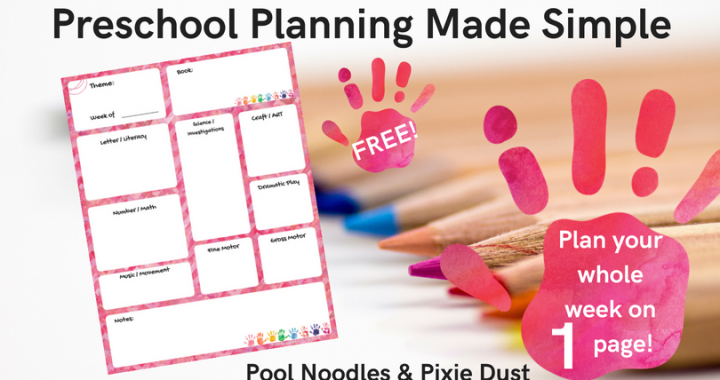
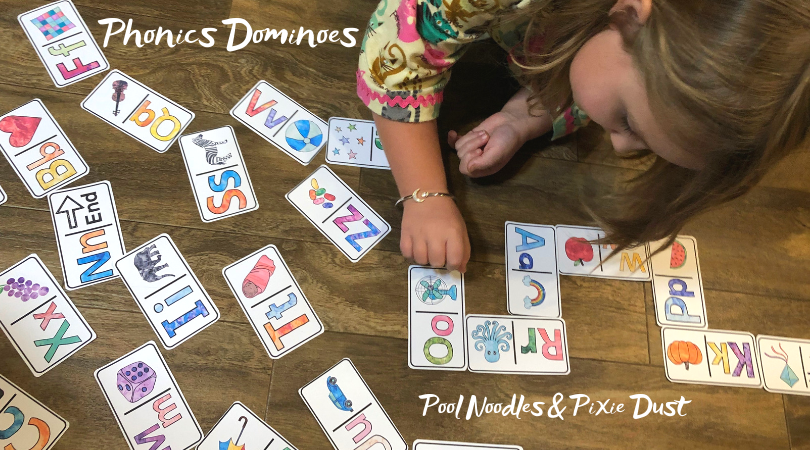
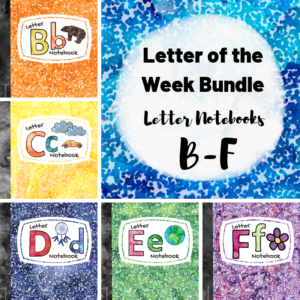
Simple is what I need. I tend to overcomplicate things.
That’s me too Tami! I can “think” things to death sometimes;) That’s why I’m constantly striving for simplicity in life and homeschooling.
Thanks for the tips!
You’re welcome!
This is so helpful in trying to figure out how to do this for the first time. Thank you!
You’re welcome, Melissa! I’m so glad this was helpful for you.